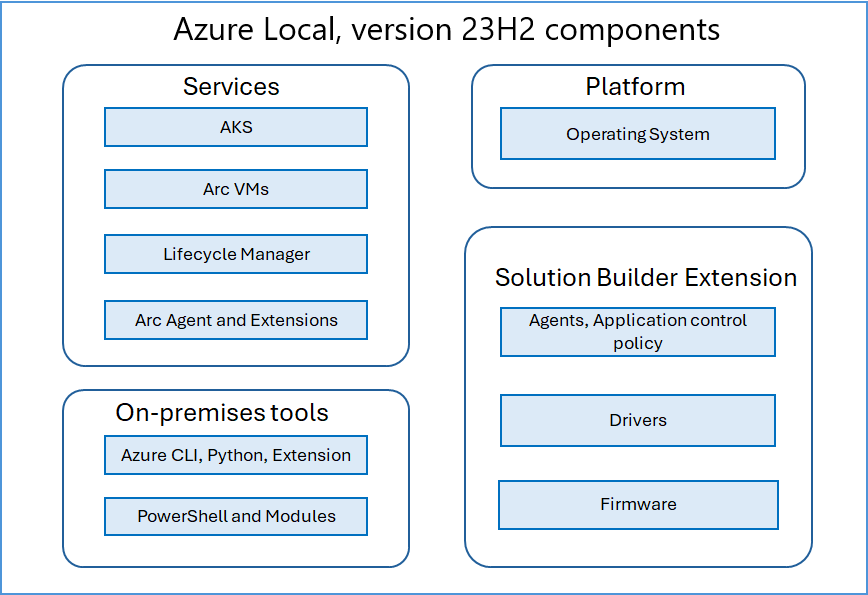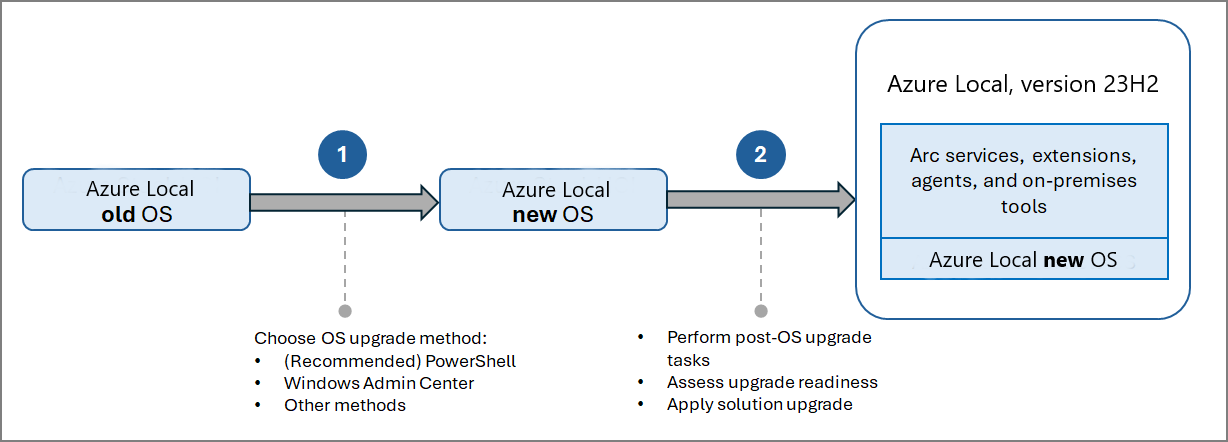About Azure Local upgrades
Applies to: Azure Local 2311.2 and later
Important
Azure Stack HCI is now part of Azure Local. Learn more.
This article provides an overview of upgrading Azure Local, version 22H2 to version 23H2.
Throughout this article, we refer to Azure Local, version 23H2 as the new version and Azure Local, version 22H2 as the old version.
About Azure Local, version 23H2
The latest version of Azure Local, version 23H2, integrates the Azure Arc infrastructure that provisions and manages the workloads such as Arc VMs, Azure Kubernetes Services, and Azure Virtual Desktop. For more information, see What's new in Azure Local, version 23H2.
With version 23H2, Azure Local evolved from a cloud-connected operating system (OS) to an Arc-enabled solution. The OS forms the base layer of this solution, with the Arc and the Orchestrator (also known as the Lifecycle Manager) components layered on top. These components are packaged together into a solution that follows an Infrastructure as code (IaC) model.
- This IaC model takes a set of input parameters that are specific to each customer and environment.
- The lifecycle manager then orchestrates the desired state across all the layers to meet the desired state and version.
The following diagram illustrates the components of the new version of Azure Local:
Azure Local upgrade versus update
An upgrade is a whole new version of software that represents a significant change or major improvement. An update, on the other hand, is a process of applying a set of changes to the software to improve its performance, security, or stability.
Azure Local, version 23H2, is a new version of the solution with a multitude of new capabilities. To move from Azure Local, version 22H2 to version 23H2, you need to upgrade your existing system. On the other hand, to ensure that you have the most recent features and security improvements for your current version of Azure Local, you would need to update your existing system.
High-level steps for Azure Local upgrade
To upgrade Azure Local from an older version, follow these high-level steps:
Upgrade the old OS to the new OS using one of the following methods:
Perform post-OS upgrade tasks.
Validate the solution upgrade readiness.
Apply the solution upgrade.
The following diagram illustrates the Azure Local upgrade process:
Supported workloads and configurations
Important
- Consult your hardware OEM before you upgrade Azure Local. Validate that your OEM supports the version and the upgrade.
- Upgrading your Azure Local from version 22H2 is only supported for regions where Azure Local, version 23H2 is available. For more information, see Azure Local region availability.
- Use of 3rd party tools to install upgrades is not supported.
Azure Local upgrade supports the following services and workloads:
| Workload/Configuration | Currently supported |
|---|---|
| Azure Kubernetes (AKS) on Azure Local | See notes Kubernetes versions are incompatible between Azure Local, version 22H2, and version 23H2. Remove AKS and all the settings from AKS enabled by Azure Arc before you apply the solution upgrade. |
| Arc VMs on Azure Local | See notes Preview versions of Arc VMs can't be upgraded. |
| Stretched clusters on Azure Local | Yes You must upgrade to Azure Stack HCI Operating System, version 23H2 to maintain your cluster in a supported state. The solution upgrade isn't applicable for stretched clusters. |
| System Center Virtual Machine Manager (SCVMM) | Yes If your Azure Local instance running version 22H2 is managed by SCVMM 2025, the OS upgrade is supported. |
| Azure Local, version 22H2SP | No This upgrade process isn't supported for upgrading from Azure Local, version 22H2 Supplemental Package clusters. |
Next steps
Choose one of the following options to upgrade your Azure Local, version 22H2 to Azure Local, version 23H2:

